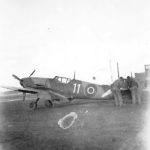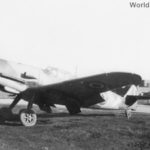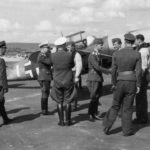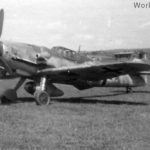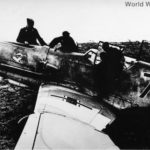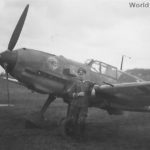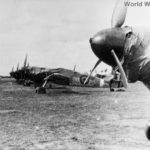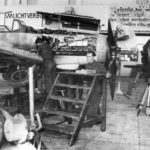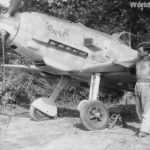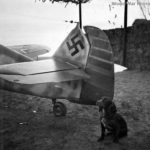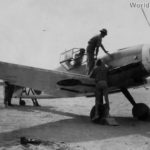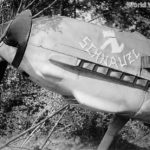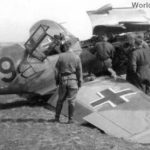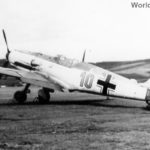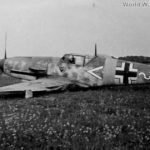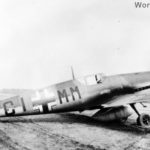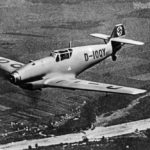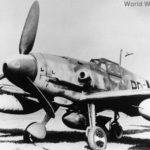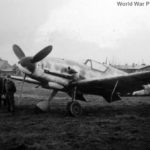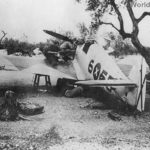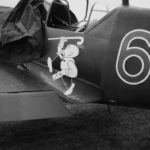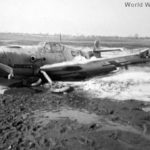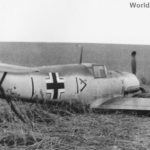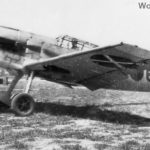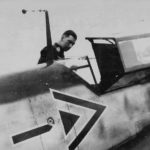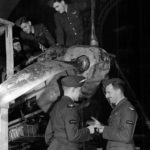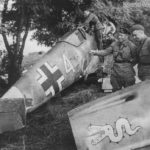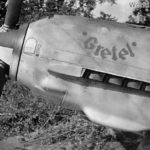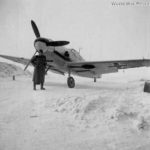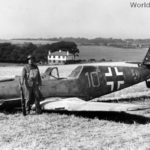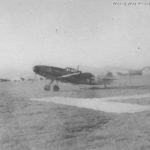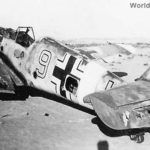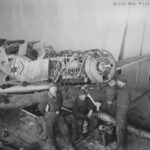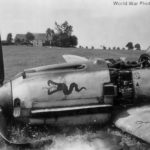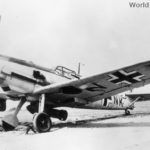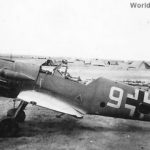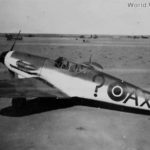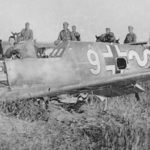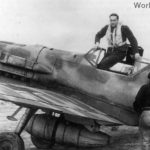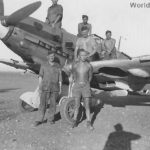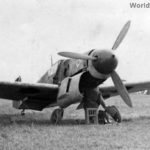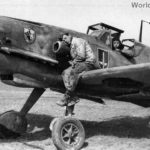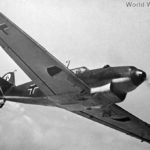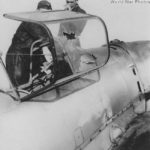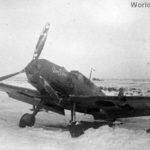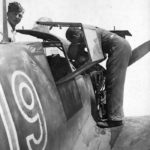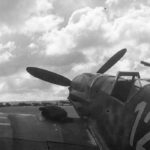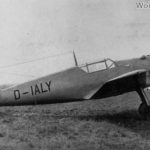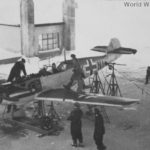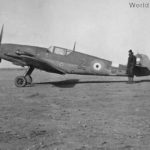Bf 109E 10 of the JG 26
Bf 109 E-5 fighters
Captured Bf 109F-4 AX-? of the 1 Squadron SAAF, North Africa 2
Bf 109 V-13
Bf 109E “7” of the II/JG 54 after a belly landing, 1940
Captured Bf 109F-4 (W. Nr. 7232 IV./JG26) “White 11” NN644 in British RAF markings
Romanian Bf 109G-2 “White 6”
British Bf109 F-2, srrial NN644
Me 109s from JG 3 Rotterdam, Summer 1940
Bf 109F from Jagdgeschwader 53 “Pik As” 1941
Changing engine on a Me 109 E of the 6/JG 51 Summer 1940
Bf 109E tail of ace Gerhard Schopfel, August 1940
Me 109 F-2 of the Stab I/JG 51, pilot Wiilli Hachfeld Stara-Russa
SdKfz 6 towing a Bf109
Bf 109G in Nurnberg, 1944
Me109E 7 of IV/JG51
Prototype Bf 109V-5 D-IEKS
Bf109E-7 of the JG51
Bf 109s on the ground 14
Romanian Bf 109Ga
Jabo Bf 109 E “14” of the 2/Sch.G. 1, Werl, Spring 1942
Bf109E of the JG 3 named Schluck Specht, 1940
Bf 109G assembly line 2
Bf 109E-4 fighters
Bf 109E from JG 3 named Gretel
Cockpit of the Junkers Ju 87 “Stuka”
Tail of the Bf 109 F piloted by Ace Werner Mölders
Bf 109 F-4/trop of the 3/JG 27 Quasaba 1942
British Bf 109F-2 “White 11” NN644
Captured Bf 109F-4 AX-? of the 1 Squadron SAAF, North Africa
Bf 109F “White 9” from IV/JG 51 November 1942
Bf 109E “4” of the JG 27, 1940
Bf109E-3 “Schnauzl” of the JG 3 piloted by Josef Heinzeller
Crashed Bf 109F “9”
Hauptmann Walter Oesau Gruppenkommandeur of III/JG 3 on his Bf 109, 1941
Me 109 of the JG5
Recon Bf109Fs being prepared for flight
Bf109E “10” of the JG 2
Bf 109 of Gruppen Adjutant of the III/JG 54, Eastern Front
Me 109F code CI+MM
Prototype Bf 109V-4 D-IOQY in flight
Me 109 E of the 5/JG 51, 1940
Crashed Bf109C 6-48 of Legion Condor
Bf 109 F “<II" of Gruppenkommandeur Hauptmann Hans Philipp of the I/JG 54 on Eastern Front
Bf 109F from JG 54
Werner Mölders and his Bf 109
Bf 109G-4/R3
Bf 109 K-4 “Kurfurst” with Erla Haube 1944
Bf 109E-3 in flight
Romanian Bf109Ga-6 #316
Bf109D of the Legion Condor
Captured Bf 109F-2 W.Nr. 12764 ex I/JG 26, 1941
Bf 109G assembly line
Bf 109E of the JG 26 with “Adamson”
Bf 109 E of the 5/JG 51, 1940
Bf 109 ground crew with parachute
Bf 109F of the JG 3 Gruppenkommandeur
RAF Bf 109G-6 serial VX101, 1944
Bf109F of Gruppenkommandeur Hans Philipp of the I/JG 54, Eastern Front
Early Me 109 F-2 code SG+GV
Abandoned Bf 109 black 11, North Africa
Ace Vladimir Kamenschikov and Bf109 of JG 3 with Tatzelwurm he downed
Me 109G-2 CC+PO
Crashed Bf 109 F “5”
Bf 109E “8” W Nr 1464
Me109s from II/JG 54
Romanian Me109G-6 Winter
Me109E of the 2/JG54
Bf 109G-6 of the JG 3
Wreck of Bf 109 G-6 W.Nr 413 601 “black 7” Uffz. Jakob Vogel 8/JG 1 Fontenay-le-Pesnil 22 July 1944
Downed Bf 109E-1 III/JG 26 piloted by Oblt. Werner Bartels during Battle of Britain
Bf 109G assembly line 3
Romanian Bf 109 E-3
Soviet Bf 109G-2
Bf 109F “White 1” of the I/JG 51
Bf 109B coded 6-6 of Legion Condor
Bf 109 “18” with Erla Haube
Captured U.S. Bf 109 G
Luftwaffe Ace Werner Molders and his Bf 109
Romanian Bf109G White 12
Me 109 E and pilot from 1/JG 2 Summer 1940
RAF pilots inspect Me109E at Southeast Air Corps Training Center
Bf109F 2 3JG3 jul41
Bf 109F 33
Bf 109 E of 5/JG 52 Summer 1940
Bf109G of the II/JG3 June 1944
Bf 109E
Romanian Me109 formation
Bf 109 captured by U.S. forces near Stendal
Me109G Eastern Front 1943
Me 109 E with SC 250 KG bomb, Pretsch April 1942
Bf 109 B 6-10 of Legion Condor
Bf109E named Gretel, 1940
Me109G +UO
Bf109F of the JG 54, Winter
Bf109V52 G-12 GJ+MG, two-seat trainer version
Early Bf109B
Bf 109E-4 W.Nr. 5587 “Yellow 10” of the 6/JG 51 shot down by PO Bryan Wicks, 24 August 1940
Captured Bf 109G-6/trop EB102 Wright Field, 1944
Me109 G of the JG 5
Me 109 E of the 6/JG 51 in Boblingen Spring 1940
Bf 109 F from 3/JG 53 Sicily Spring 1942
Abandoned Bf 109F-4 W.Nr. 12564 “Yellow 9” of the 9/JG 53 Africa
Crashed Bf 109E “White 9” of the 1/JG 51
Crashed Messerschmitt Bf109E
Bf 109 F-2 Stab I/JG 51, pilot Wiilli Hachfeld Stara Russa
Bf109E of the JG3
Bf 109E-3 Jabo CA+NK
Prototype Me109F-0 W.Br 5604 VK+AB
Abandoned Bf109 :White 9″ in African Desert
Messerschmitt Bf109E of the III/JG 27
Captured Bf 109F-4 AX-? of the 1 Squadron SAAF, North Africa 3
Me 109C of the JG 2 “Richthofen”, Karlsbad 1938
Me 109E-3 in flight
Me109 E-3 CA+NK
Crashed Bf109E of the III/JG 77 Eastern Front
Pilot climbs out of cockpit of Bf109E
Bf109 of Geschwaderkommodore of JG 54, Eastern Front
Bf 109E of the I/JG76 Poland 1939
Bf109E 15
Messerschmitt Bf109E-7 of the JG26
Bf 109F of the JG 53 Russia
Adolf Galland and his Messerschmitt Bf 109 E
Bf 109 “16” of the III/JG52
Romanian Bf 109G-6 W.Nr. 166133 piloted by Constantin Cantacuzino in US markings
Bf109 of the I/JG 52
Me109 B-1 in flight
Bf 109F of the JG 53
Damaged canopy of Me 109 E from 6/JG 51 France 1940
Bf109G-6/R6/U2 W.Nr 412951 of the 1/JG 301 piloted by Lt Horst Prenzel
Crashed Bf 109E “10”
Bf109F of the Geschwader Molders
Captured by 1 Squadron SAAF Bf 109F-2 Yellow 2 ex 9/JG 27, 1942
Abandoned Bf109 in African Desert 1
Romanian Bf109G White 4
Romanian Bf109E named Don Pedro
Me 109 F-4 “19” from JGr Sud, Marseille Marignane 1943
Me 109 G-6 Spring 1944
Prototype Bf 109V-7 D-IALY
Me109G-6
Bf 109E 4
Ground crew performing maintenance on a Bf 109G
Romanian Bf109G-6
Bf109F-2/trop of the 1 Squadron SAAF
Captured Bf109F
The Messerschmitt 109 was the standard fighter of the Luftwaffe for the duration of World War II, although it began to be partially replaced by the Focke-Wulf Fw 190 starting in 1942. The Bf 109 scored more aircraft kills in World War II than any other aircraft. At various times it served as an air superiority fighter, an escort fighter, an interceptor, a ground-attack aircraft and a reconnaissance aircraft. Although the Bf109 had weaknesses, including a short range, and especially a sometimes difficult to handle narrow, outward-retracting undercarriage, it stayed competitive with Allied fighter aircraft until the end of the war.
The Bf 109 was flown by the three top scoring fighter aces of World War II : Erich Hartmann, the top scoring fighter ace of all time with 352 victories, Gerhard Barkhorn with 301 victories, and Günther Rall with 275 victories. All of them flew with the Jagdgeschwader 52, chiefly on the Eastern front, a unit exclusively flying the Bf 109 models and being credited with over 10,000 victories itself. Hartmann refused to fly any other aircraft in combat throughout the war. Hans-Joachim Marseille, “The Star of Africa” also flew the Bf 109, and achieved all of his 158 victories on the Western Front, chiefly against Allied pilots in North Africa, including 17 aircraft shot down in a single day.
The Bf 109 will always be compared to its adversary, the Supermarine Spitfire; both were among the best of their day.
Bf 109 was the initial Reichsluftfahrtministerium (the German Air Ministry) designation, since the design was sent in by the Bayerische Flugzeugwerke company, and used exclusively in all official German documents dealing with this aircraft family. After the company was renamed to Messerschmitt AG after July 1938, when Erhard Milch finally allowed Willy Messerschmitt to acquire the company, from that date forward, all Messerschmitt aircraft were to carry the “Me” designation — at least in theory, as wartime documents from Messerschmitt AG, the RLM and others continued to use both designations, sometimes even on the same page. Me 109 is known to have been the name used in print by the Luftwaffe propaganda publications as well as by the Messerschmitt company itself after July 1938, and the Luftwaffe personnel, who pronounced it may hundert-neun. The Me 109 (pronounced “emm ee one-oh-nine”) designation was usually used in the English-speaking world. However, in both wartime and contemporary literature, both the “Bf” and “Me” prefixes are used, and both are considered valid and accurate — although some debate still occurs over this issue from time to time.
Messerschmitt had already designed much of the Bf 109 by this point. Like the Bf 108, the new design was based on Messerschmitt’s “lightweight construction”, which essentially aimed to reduce the total number of strong parts in the aircraft as much as possible. One of the more notable examples of this was the mounting of all structural points to a strong firewall at the front of the cockpit, including the wing spars, engine mounts and landing gear. In more conventional designs these would be mounted to different points on the aircraft, with a framework distributing the load among them.
Another notable advantage of this design was that, since the landing gear was attached to the fuselage itself, it was possible to completely remove the wings of the aircraft for major servicing, if necessary, leaving the fuselage intact sitting on the landing gear. However, this had one major drawback — such a landing gear arrangement ensured a narrow track (the distance between the main tyres) which thus made the plane unstable in terms of balance while on the ground. In fact, the Bf 109 was notoriously difficult to take off and land, and many planes simply veered off or tipped over to one side during a seemingly perfect run. To make things worse, the landing gear struts were comparatively long. This left the nose pointing up at quite a steep angle with respect to the ground, making forward visibility during taxiing near zero.
The Bf 109 suffered from ground accidents due to “swing” on takeoff and landings throughout its life. It has been suggested that 5% of all 109s were lost this way, or even one third; the Luftwaffe’s loss records on the other hand show that approximately 1% of the Bf 109s had suffered landing incidents or accidents at the beginning of its career, a figure comparable to the other monoplane fighters introduced at the time. This feature was, however, more of a problem with rookie pilots, especially during later stages of the war. The interesting fact is that Spitfire had a similar , narrow landing gear arrangement, but there hasn’t been widespread talk about operational losses, and it has been speculated that the swing was due to the toe-in of the main landing gear wheels. Most Finnish pilots report that the swing was easy to control, but some of the less experienced pilots lost planes on startup.
Reflecting Willy Messerschmitt’s belief in low-weight, low-drag simple monoplanes the armaments were placed in the main body of the plane; two machine guns were mounted above the engine and a third could be fired through the airscrew hub, with the engine buffering the recoil. Fitting with Willy’s ethos, this kept his gun-free wings very thin and lightweight. When it was discovered that the RAF was producing eight-gun monoplanes it became clear that the Bf 109 would have to carry more guns and a new wing was designed holding a machinegun, later a 20 mm MG FF cannon.
In 1938 the ‘Emil’ (see below) went into production, but to improve on the performance allowed by the rather small 600 to 700 hp Jumo engine the larger Daimler Benz DB 601A engine was used, yielding an extra 300 hp at the cost of an additional 400 lb.
Another aspect of this construction technique was the use of a single box-spar in the wing, mounted near the leading edge. Most planes of the era used two spars, near the front and rear, but the box was much stiffer torsionally, and eliminated the need for the rear spar.
Another major difference was the much higher wing loading than the other designs. While the R-IV contract called for a wing loading of less than 100 kg/m², Messerschmitt felt that this was unreasonable; with the engines available to them, the fighter would end up slower than the bombers it was tasked with catching.
A wing generates two forms of drag, parasitic drag due to its form, and induced drag which is a side effect of generating lift. The former dominates at high speeds, when the airflow hitting the wing causes drag that rises with the square of the aircraft’s speed. The latter dominates at lower speeds, where the lack of airflow requires the wing to be angled into the airflow at a higher angle of attack. Since the fighter was being designed primarily for high speed flight, a smaller wing would be optimised for high speed use.
The downside of such a trade-off is that low speed flight would suffer, the smaller wing would require more airflow to generate enough lift to stay flying. In order to address this, the Bf 109 included advanced high-lift devices on the wings, including automatically opening slats on the leading edge, and fairly large camber-changing flaps on the trailing edge. He also included ailerons that “drooped” when the flaps were lowered thus increasing total flap area when the flaps were deployed. When deployed, these devices effectively increase the coefficient of lift, making it better at low speeds and high angles of attack.
Another drawback of the high wing-loading is that the plane would require more energy to manoeuvre. Given the limited amount of power available, this effectively meant that the Bf 109 would not be able to turn as tightly as other designs with larger wings. The high lift devices would offset this to some degree, but they also increased drag and so slowed the plane further. Given that manoeuvrability was last on the RLM’s wish-list, Messerschmitt was certain the benefits outweighed the drawbacks.
The first prototype (Versuchsflugzeug 1 or V1), with civilian registration D-IABI, was completed by May 1935, but the German engines were not yet ready. In order to get the designs into the air, the RLM acquired four Rolls-Royce Kestrel VI engines by trading Rolls-Royce a Heinkel He 70 Blitz to test their engines on. Messerschmitt received two of these engines, and started work on adapting V1 to mount it. This work was completed in August, and V1 took flight tests in September 1935. It was then sent to the Luftwaffe Test Center at Rechlin to take part in the contest.
By the late summer the Jumo engines were starting to become available, and V2 was completed with the Jumo 210A of 610 PS ( 602 hp, 449 kW) in October 1935. V3 followed, being the first to actually mount guns, but another 210 was not available and it ended up delaying the flight of V3 until May 1936. Like V1, V2 and V3 were sent to Rechlin after acceptance tests at the factory.
The flight data of these three planes were very nearly identical. The maximum airspeed was about 470 km/h at 4000 m altitude, and the service ceiling was about 8300 m.
After Luftwaffe acceptance trials were completed at Rechlin, the planes were moved to Travemünde for the head-to-head portion of the contest. The Heinkel design arrived first, in early February 1936, and the rest of the V1s had all arrived by the beginning of March.
Because most of the fighter pilots of the Luftwaffe were used to good-natured biplanes with open cockpits, light g-forces and easy handling, they were very critical about the Bf 109 at first. However it was soon a front-runner in the contest, as the Arado and Focke-Wulf entries proved to be hopelessly outdated. Perhaps this isn’t surprising, considering that those entries had actually been designed two years earlier, and given the rate of change in aircraft design at the time, they really had little chance against the much more modern 109.
The only serious competition to the 109 was the Heinkel entry. Based on a scaled down Blitz, the He 112 proved to be similar but different. Positive aspects of the He 112 included the wide track and robustness of the landing gear, considerably better visibility from the cockpit, and a lower wing loading that led to easier landings and better maneuverability. But the Bf 109 was 30 km/h faster than the He 112 in level flight, and also was superior in climbing and diving. Still, the He 112 was the favourite of the Luftwaffe leaders.
On 11 November 1937 Messerschmitt regained some favour with Erhard Milch with the Bf 109 V13 increasing the world’s air speed record to 379.38 mph. The ‘V13’ had been fitted with a special racing version of the DB 601 engine, as a result the power of the engine could reach 1,650hp for short periods.
Heinkel, having had the He 112 rejected began work on the He 100. On 6 June 1938 the He 100 V3, flown by Ernst Udet, established a new record of 394.4mph, and later on 30 March 1939 surpassed that record reaching 463.92mph with the He 100 V8. Messerschmitt soon regained the lead in this race. On 26 April 1939 Hans Dieterle, flying the Bf 209 V1, powered by the DB 601ARJ, producing 1,550hp but capable of reaching 2,300hp, raised the figure to 469.22mph. This world record was to stand until 1969.
Orders for a further ten examples of both types were placed, and they started trickling in over the next few months. However by this point the Jumo-powered examples of both designs had arrived for testing, and the 109’s better streamlining and lower drag meant that it was considerably faster given the lower-power engine.
Even before the pre-production models arrived the contest was basically over. In March the RLM received news that the Spitfire had been ordered into production, and a form of mass panic broke out. On March 12 they released a document that basically contained the outcome of the contest, Bf 109 Priority Procurement. Nothing occurred over the summer to change their minds, and the RLM instructed Heinkel to re-design the He 112 radically, while ordering the Bf 109 into production.





